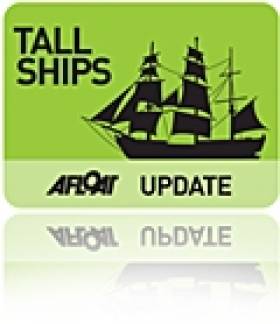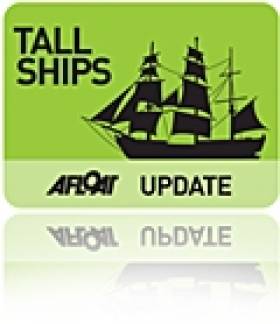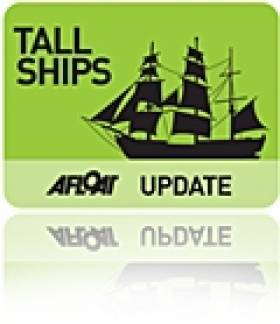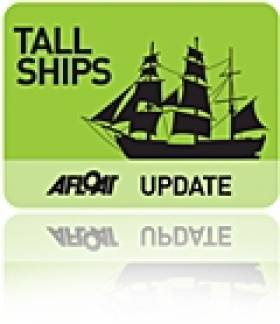Displaying items by tag: Tall ship
#tallship – The first Bantry Longboat ever built in the Midlands will go sailing on the Shannon at Banagher in County Offaly. It will be some sight when it does, bringing involvement with the Atlantic Challenge which organises international competition of these boats, to what can fairly be described as Ireland's greatest river system.
If that major event should itself be held in future years on the Shannon, what a great occasion it would be.
I met some of those who built it the Banagher Longboat at the Glandore Classic Boats Summer Maritime School where one of them, Noel Ryan, told me that it took 5,036 man hours. Another of the group, Willie Kirwan, added that they would have "done it quicker if we were tradesmen, but we were all learners without experience, so we had a lot of tea breaks! If we were tradesmen we would have been quicker, but we enjoyed it and we have a fine boat."
They have indeed and those who built it will be testing it out in August. "We want to make sure it goes well, we wouldn't want any embarrassment," said Willie jovially, "but we are sure it won't sink, though we will have to learn about the skill of rowing and sailing this boat."
Indeed they will. I had the pleasure of sailing in the Bantry Longboat which was built in Bantry a few years ago. When it sailed on a reach it could reach a pretty quick speed and I found it was the skill of the crew in balancing the boat which kept it upright. You needed to be lively, as the longboat doesn't have a keel.
"We learned a lot, new things every day, building a boat can be tough and demanding but it is definitely enjoyable and rewarding when you see it finished," Noel said.
They have a lot of pride in their boat which was built with as the West Offaly Bantry Bay Longboat Project, originally a Men's Shed initiative with support from Offaly Local Enterprise Development Company, West Offaly Enterprise and County Offaly VEC, the latter of whom apparently thought the job might be done in three months!
The boat has led to the formation of the Midlands Atlantic Challenge Club, which intends to organise involvement with schools, youth, sports and corporate groups.
Twelve countries are members of the Atlantic Challenge organisation – Belgium, Canada, Denmark, Finland, France, Great Britain, Indonesia, Italy, Russia, USA, Ireland and Northern Ireland are separate members.
The original longboat, also known as an admiral's barge, was built in Brest, France, over 200 years ago. The boat is similar to the Captain's gigs used at that time by the navies of France, Sweden, Russia, Spain, Sweden and the USA. When the French Armada arrived off the South/West coast of Ireland in 1796 it ran into a gale and, through lack of leadership, decided to return to France. But the longboat from the vessel which Wolfe Tone was aboard, while trying to establish communication with other ships, was blown ashore in Bere Island and the crew were captured by British forces. This boat is preserved in the National Museum at Collins Barracks in Dublin. Built in1790, it is the oldest surviving vessel of the French Navy.
So, what have these Bantry Longboats got to do with whether Ireland should have a tall ship?
Hal Sisk, legendary figure in the traditional boats sphere and a man never reluctant to take and express a different view and to advance that, even if controversial, was also speaking at the Glandore Summer School in his role as sailor, author and yachting historian, on the topic: 'The origins of the sport of modern amateur sailing.'
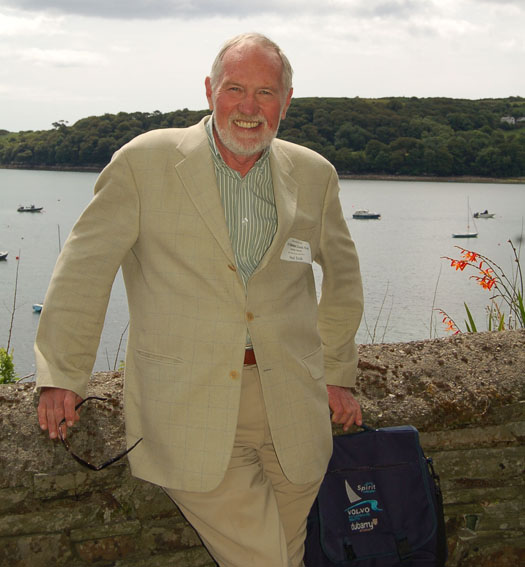
Hal Sisk
Hal advanced a different view about the thrust of sail training than Ireland having a tall ship for the purpose:
"To get people out on the water, in a team concept, providing physical exercise and with international competition, all of that could be achieved with an alternative of a fleet of 30 Bantry Longboats, several of which have already been built in Ireland. There are 35 worldwide and a fleet of them in Ireland would provide, at dramatically reduced cost, what a sail training ship delivers in sail training."
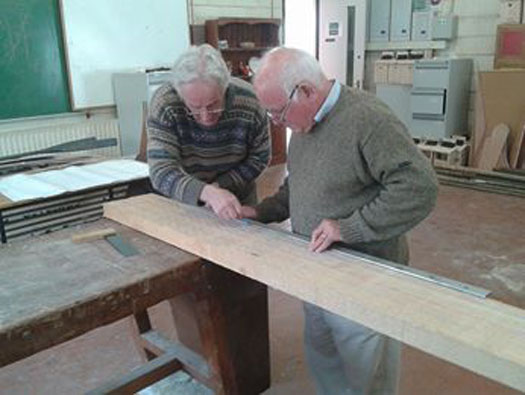
Building The Banagher Bantry Longboat
I put it to him that this would exclude the role of international representation which, for example Asgard had done well and, in modern terms, requirements to provide for disabled trainees.

Bantry Longboat Fionbarra
"I acknowledge what you say, but these boats have fantastic international competition. They are all built the same wherever they are, whereas in the race of sail training ships, it is pretty much based on handicap, it is not a race between identical boats. The Bantry longboats provide this, they come together every few years in international competition and have been built far away, in Indonesia, Russia, for example. You would get true, fair, international competition. They don't fly the flag in a spectacular way in international representation terms as Asgard did for example or as does a beautiful square-rigged tall ship, but there always was an alternative in the replacement of Asgard after she sank.
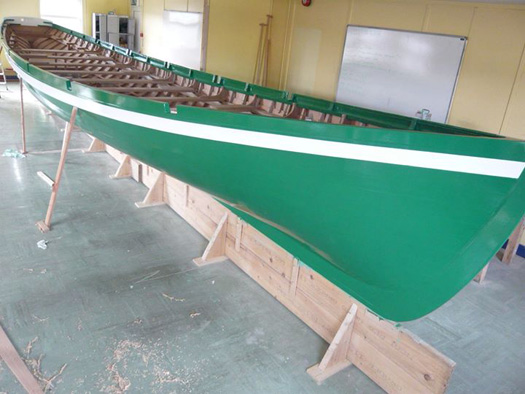
The Banagher Bantry Longboat
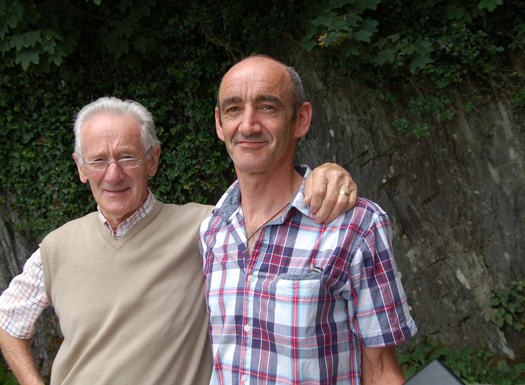
Willie Kirwan And Noel Ryan - Banagher Boat Builders

The Oldest Vessel Of The French Navy - The Original Bantry Longboat In Ireland's National Museum
"Ireland could have bought a steel-hulled topsail schooner for about €2m, or so and have her for that function, but I would argue that, as against the building of a new tall ship we could build a fleet of Bantry Longboats. We must also remember the cost of maintenance and operation of a tall ship, crewing and health and safety requirements. But a fleet of Bantry longboats would be out on the water far more often probably and could be built for maybe a million and would provide more use for more trainees and the cost, against that of a sail training ship, would not be just very much less, but substantially less by my calculations."
Hal has sent me statistics to make his point - that actual use and benefits in providing sail training and general seamanship for many more young people would be at much less cost for a fleet of 30 Bantry Longboats compared to a tall ship and would be of much greater benefit.
"Bantry Longboats could be spread around the country, built locally and therefore also building on town and parish pride and maintaining coastal traditions also. It is a historic boat, authentic, distinctive, with that huge international competition dimension."
The case Hal Sisk makes is interesting, while at present efforts continue through what was formerly called the 'Pride of Ireland Trust' now changed to the 'Atlantic Youth Trust,' to build a new Irish tall ship, the concept design for which has been completed. The name change followed consultation on both sides of the Border, after which it was decided that 'Pride of Ireland Trust' did not represent the views of all stakeholders and "therefore did not represent the ethos of the organisation, so in order to create a name that has a true sense of neutrality, a strong maritime focus, a sense of adventure and one that carries weight in America, 'Atlantic Youth Trust,' was chosen as the name to offer unique Youth and Cultural Development opportunities, to help the island reach its maritime potential and to create a flagship that will represent the island on an international platform," amongst other aims.
I will be interested to hear response to the views of Hal Sisk.
THE GOVERNMENT IS HOLDING €3.8m. IN ASGARD COMPENSATION WHICH IT SHOULD RETURN TO THE MARINE SECTOR
It remains a blot on the maritime reputation of this island nation that the €3.8m. insurance paid for the loss of Asgard was put into general Government funds by former Defence Minister Willie O'Dea, rather than being held for the specific purpose of a replacement national tall ship, even if that would be provided outside of Government.
I was never impressed by the administration of Asgard during my years as a national marine correspondent. I expected far more commitment and determination in support of the maritime interests of this nation. When Willie O'Dea appeared to confuse 'vehicle' and 'vessel' in his answers on a radio interview about the sinking of Asgard, then refused several attempts by me to get an interview with him about his decision in regard to giving the Asgard insurance money to the State and other decisions he made when the equestrian requests of the Army for horses, were considered more important than Asgard, I realised that the Limerickman who declares on his website - 'Working for You' - did not show much commitment to working for the national tall ship. I offered to go anywhere, anytime, to interview him, but through his officials, he always found a reason not to be available.
Whether for Bantry Longboats or for a tall ship, it is my view that there is €3.8m. in State funds which is morally due to either project and the Government should acknowledge and provide that.
No less is required of the Government of an island nation.
#tallships – An American tall ship is open for public tours Sunday, June 29, 2:00pm until 5:00pm at Custom House Quay in Cork.
As Afloat reported earlier, the Sea Education Association's tall ship, the SSV Corwith Cramer, will be docked at Port of Cork City Marina, Custom House Quay following a transatlantic sail from the United States to Cork, Ireland.
SEA Semester/Sea Education Association invites the public to attend an open ship, Sunday, June 29 from 2:00pm until 5:00pm onboard the SSV Corwith Cramer at Custom House Quay in Cork. Public tours will be given. The 134-foot brigantine tall ship is the most sophisticated research vessel under sail in the United States and serves as home and classroom for undergraduate students participating in SEA Semester® study abroad programs focusing on the exploration, understanding and stewardship of the oceans.
The ship's arrival in Cork marks the completion of the SEA Semester Transatlantic Crossing summer study abroad programme that began June 1 in Woods Hole, Massachusetts. This is the first time in over twenty years that SEA Semester and the SSV Corwith Cramer have made the transatlantic journey, and represents an inaugural program ushering in a new suite of voyages featuring cruise tracks along the western coast of Europe, the Mediterranean and the Canary Islands (www.sea.edu/Europe).
Spanish Royal Navy Tall Ship Arrives in Dublin Port
#tallship – This morning saw the world's third-largest Tall Ship, the Juan Sebastián de Elcano, greeted by Dublin Port Company tug boats and a flotilla of yachts from local sailing clubs in a ceremonial escort to mark the ship's arrival in Dublin Port.
As Afloat.ie reported earlier, the magnificent 370ft, four-masted steel-hulled Royal Spanish Navy schooner will be open to the public to visit for free during her five-day stay in the capital to promote Spanish-Irish cultural exchange. Click HERE for public opening dates, times and locations.
Tallship – The world's third largest tall ship is currently anchored in Dublin Bay and waiting to come into Dublin Port where it will open to the public. The Spanish 370–foot long, four-masted Juan Sebastián de Elcano – is set to sail into Dublin tomorrow (7 June) for a five-day visit.
This majestic ship will be open to the public at the following times:
At Sir John Rogerson's Quay from 12pm to 1pm and 3.30pm to 7pm on Sunday 8th June, and from 10am to 12pm and 3.30pm to 7pm on Monday 9th June
Then later at Alexandra Basin from 3.30pm to 7pm on Tuesday 10th June, and from 10am to 1pm and from 3.30pm to 7pm on Wednesday 11th June. Access to the ship in Alexandra Basin is via a free shuttle bus service from Dublin Port Company's headquarters on Alexandra Road, Dublin 1.
As Afloat.ie reported earlier, The steel-hulled schooner will be escorted into Dublin Port at 7.30 am Saturday Morning by two Dublin Port Tug Boats and local yachts in Flotilla. Cruisers and yachts are welcome to take part.
Led by Captain Enrique Torres Piñeyro, the Elcano is used primarily as a training ship for the Royal Spanish Navy, preparing its officers for long periods at sea.It will arrive in Dublin with 191 crew, who will participate in a five-day programme of engagements to promote Spanish-Irish cultural exchange.
The ship, currently is on its 85th training voyage and has been sailing for 23 days across the Atlantic from the Port of New York to Dublin Port. Built in Cádiz (Spain) in 1928, the Elcano has visited 152 ports in more than 70 countries, and of its 85 cruises to date, 10 have been round-the-world trips. The Elcano last visited Dublin in July 1999. After leaving Dublin next Thursday, it will visit Hamburg, Germany and Fredrikstad, Norway before returning to Spain.
World's Third Largest Tall Ship is Dublin Bay Bound
#tall ship – Straight after a weekend of Tall Ships on Dublin Bay, the Spanish Embassy in Dublin and Dublin Port Company have announced that the world's third-largest Tall Ship, the 370 foot long, four-masted "Juan Sebastián de Elcano" will visit Dublin from Saturday, 7th until Thursday, 12th June.
The impressive steel-hulled schooner will be met by two Dublin Port Company tug boats and a flotilla of yachts from local sailing clubs in a ceremonial escort to mark the ship's arrival at 7.30am this Saturday in Dublin Bay.
Led by Captain Enrique Torres Piñeyro, the "Elcano" is used primarily as a training ship for the Royal Spanish Navy, preparing its Officers for long periods at sea. She will arrive in Dublin carrying 191 crew on board, who will participate in a five-day programme of engagements in the capital to promote Spanish-Irish cultural exchange.
This includes a number of free public open days, when Dubliners and visitors to the city will be able to board and inspect this magnificent vessel up close in the following locations:
At Sir John Rogerson's Quay:
Sunday 8th June: 12.00 to 13.00 and 15.30 to 19.00;
Monday 9th June: 10.00 to 12.00 and 15.30 to 19.00
At Alexandra Basin*:
Tuesday 10th June: 15.30 to 19.00;
Wednesday 11th June: 10.00 to 13.00 and 15.30 to 19.00
The ship, now on its 85th training voyage, has been sailing for 23 days across the Atlantic from the Port of New York en route to Dublin Port. Built in Cádiz (Spain) in 1928, the "Elcano" has visited 152 ports in more than 70 countries, and of its 85 cruises to date, 10 have been round-the-world trips. The last time the "Elcano" visited Dublin was in July 1999. Her next ports of call include Hamburg, Germany and Fredrikstad, Norway before returning to Spain.
Eamonn O'Reilly, Chief Executive of Dublin Port Company, said: "Dublin Port Company is delighted to welcome the Juan Sebastián de Elcano and her crew to Dublin Port. As a PORT CITY, it's an honour for Dublin Port to host the world's third-largest Tall Ship in full view of the city, where she is certain to receive a very warm welcome. I would strongly encourage Dubliners and visitors to the city to take this unique opportunity to visit this spectacular naval ship, and share in Spain's maritime history and culture over the coming days."
Javier Garrigues, Spanish Ambassador to Ireland, said: "The arrival to Dublin of the Elcano is an event of major importance and significance. It symbolises the strength of the bilateral relations between Ireland and Spain, two nations united throughout history by close ties, nowadays reinforced by their common membership of the EU. The fact that Dublin has been chosen as a port of call by the Elcano is proof of the importance Spain attaches to Ireland. I am convinced that Elcano´s visit will further enhance the mutual understanding and friendship between the two countries."
#tallships – Last July, eight youngsters from Ireland that were taking part in a voyage on the Tall Ship "Astrid" got more than they bargained for when the ship got into difficulty near Kinsale during an Irish Sailing Association 'Gathering Cruise' and foundered on rocks. Nine months later, the 100–year–old Dutch ship's journey finally came to an end in a skip when it was cut up for scrap. Here Michael Byrne of Sail Training Ireland relates the outcomes of the ordeal for the 24 trainees from five countries and how the Irish trainees are now back at sea this week on an Irish Vessel, the 'Spirit of Oysterhaven', a vessel that was involved in Astrid's crew rescue.
There were two striking outcomes after the ordeal.
1. How closely the trainees had bonded during their previous ten days at sea, evident in how they cared for each other and how difficult they found it to disband the group when the time came.
2. How anxious they AND THEIR PARENTS were to get them back to sea.
This week that dream came through for some of the Irish Trainees who are taking part in a 5 day voyage on the Cork Coast, largely coordinated by themselves, on Irish Sail Training Vessel "Spirit of Oysterhaven" a 70' Schooner based in Cork. The voyage is part of a "Youth Initiative" project, funded by the EU Commissions "Youth in Action" programme, and overseen by Sail Training Ireland which includes a total of 8 trainees.
The educational programme of activities and workshops is based on environmental awareness and the "Leave no Trace" policy. The trainees are examining the level of rubbish at sea and will be making a public demonstration by building a sculpture out of rubbish they collect.
Sail Training focuses on the valuable life skills that are developed in the participants through the experience of life at sea on a sailing vessel such as; self-confidence, resilience, responsibility and a willingness to rely on each other. Trainees become part of a working crew of the Tall Ship or Sailing Vessel and must work together to operate the ship day and night. Such voyage are excellent opportunities to develop important skills and characteristics and also to develop educational concepts such as environmental awareness, cultural awareness, citizenship and leadership.
Sail Training Ireland, and its members, continue to work to develop more of these programme so that the young people of Ireland have the opportunity to experience life at sea, explore our maritime heritage as a seafaring nation and benefit from the adventure of a lifetime.
There are many more voyages taking place in 2014 both on Spirit of Oysterhaven and on various other Tall Ships that have been arranged to visit our ports.
7 Tall Ships will sail from Belfast to Dublin at the end of May with over 100 young people aged 16-27 years funded to sail on board.
#tallship – The German Embassy in Dublin has announced the arrival of the GORCH FOCK, Tall Ship and Training Vessel of the German Navy. The vessel will pay a visit to Ireland from March 13th to 29th, 2014. It will be berthed at Cobh Cruise Terminal in the Port of Cork.
The crew will be happy to welcome the public for "open ship" events on Sunday, March 16th, and Sunday, March 23rd, from 2 – 5 p.m.
All are welcome, admission is free, no prior registration is required.
Tall Ship Astrid Back From the Deep, Dutch Vessel Successfully Raised in Kinsale
#astrid – The Dutch Tall Ship Astrid that ran aground two months ago has been successfully recovered off the Cork coast today. Using specialist lifting equipment brought in from England, the 100– foot steel hull, now safely atop a massive barge, is remarkably intact as the pictures below, taken by Erskine Tanner at Kinsale harbour, show.
News of the salvage before the arrival of any autumn gales has been warmly greeted. The lift brings an end to the saga for all involved during the rescue of those on board, during her protection while she was on the rocks and in her salvage this week.
A Marine Casualty Investigation Board (MCIB) report is being prepared into the accident.
The 95-year-old vessel ran aground on to Rocks off Kinsale two months ago during a photocall for the Irish Sailing Association Gathering Cruise promotion, prompting dramatic scenes as 30 people were rescued from rough seas. The vessel has been resting on the rocks since the grounding on July 24th.
The vessel hit rocks inside the Sovereign Islands at Ballymacus Point, near Kinsale.
The training ship had lost power and was apparently driven on to rocks by a strong southerly wind at the western entrance to Kinsale Harbour. The grounded vessel quickly took on water and these pictures show where the steel hull was holed.

Mediterranean Voyage of 'Spirit of Oysterhaven' Schooner
#tallships – Ireland's largest sail training vessel, the 70 foot schooner "Spirit of Oysterhaven", has recently completed her crossing of Biscay to Spain with a crew of seven under skipper Tom O'Leary. An intense high pressure system delivered 15 to 20 knots for the start of the voyage before dying to a windless calm, with Spirit quietly motoring through fields of phosphorescence at night and joined by dolphins on the bow-wave by day. Then by the
time she passed Cape Finisterre of the North West tip of Spain she was running at 9 knots before a force 7.
She is currently making her way down the Portuguese coast prior to rounding the Straits and then heading for Barcelona where she is due to participate in the Mediterranean Tall Ships Regatta at the end of September. "This is a very exciting event for us", commented owner Oliver Hart, " as we were invited to participate following our involvement in Dublin Tall Ships in 2012. We still have a few berths available on both voyages, and we are
looking for delivery crew to help us bring Spirit back to Alicante after the event."
The Mediterranean Tall Ships Regatta is a chance to join the Spirit of Oysterhaven for an unforgettable cruise in the company of a fleet of Tall Ships from Barcelona in Spain on Sunday 22nd September to Toulon in France and finishing in La Spezia in Italy on Sunday 6th October.
Salvage of Tall Ship Astrid Begins off Kinsale
#tallship – A salvage operation to remove the wreck of the Tall Ship Astrid from rocks off Kinsale is underway. The operation will involve specialist marine crane equipment brought in from the UK. The 95-year-old vessel ran aground at Rocks off Kinsale last month during a photocall for the Irish Sailing Association Gathering Cruise promotion, prompting dramatic scenes as 30 people were rescued from rough seas. The vessel has been resting on the rocks since the grounding on July 24th.
The operation is expected to take between one and two weeks, depending on weather conditions. A lifting barge and crane are due on site over the next couple of days.
Divers with the company have already completed a survey of the wreck and submitted a report to Coastguard officials on Monday.
For a month after the accident Astrid made a sad picture, still trapped on rocks, her beautiful sails torn and ripped by the sea but amazingly her rig still intact.
The vessel, which was built in 1918 and operated as a cargo ship until 1975, was on a 14-day voyage as part of an EU Youth in Action programme sailing from Southampton to Cherbourg via Kinsale. The Astrid departed Oysterhaven for Kinsale but lost power during a photocall with seven crew and 23 trainees on board.
For more on Astrid's sinking click Afloat's Tall Ship news section.




























